Which comes first wax or poly? As a furniture painter, I’m constantly asked the question of whether you can apply wax over polyurethane or polyurethane over wax. While it reminds me of that age-old question about the chicken and the egg, there is an actual answer and a few rules to the questions of wax over poly or poly over wax.

Poly vs. Wax
In most instances, a single protective topcoat is all you need; but sometimes there’s reasoning behind applying both wax and polyurethane protective finishes.
Polyurethane is an oil-base liquid that usually hardens in less than 24 hours (humid climates may take longer). Polyurethane is one of the best and most protective topcoats available on the market and can last for years (50+). Even the satin polyurethanes have a slightly glossy protective finish.
There are water-based polyurethane’s (some known as polycrylics), but for simplicity purposes in this article, we are discussing oil-based polys here.
Wax is an oil-based paste that cures in about 24 hours. Wax does not harden to the capacity that polyurethane does, although it does protect furniture. Wax may soften in direct sunlight or near heat so you do need to be careful not to place furniture next to hot radiators or in an area that gets really warm due to direct sunlight. I’ve never had a problem in moderate indirect sunlit areas.
Wax has a soft sheen and buttery-smooth finish. It does wear down over time and may need to be re-applied after a several years. Dining tables may require re-application after just 3 to 5 years while dressers and coffee tables may only need re-application after 10 years or more. It depends on the amount of wear and tear on the tabletop.
While either one of these topcoats on their own should offer plenty of protection, sometimes people want the protection of polyurethane but the soft sheen and buttery feel of wax. Or perhaps they would like to tone-down the sheen on a high-gloss polyurethaned finish. In my experience as a furniture refinisher that has run into the later situation, here is the correct way to use both wax and poly on a piece of furniture?
Poly First, Then Wax
This past Fall I refinished this antique dresser with a black Polyshades stain. Polyshades stain has an oil-based polyurethane built right into the mix. Another topcoat wasn’t required, but I wanted a soft sheen and buttery feel that only comes with a waxed topcoat.
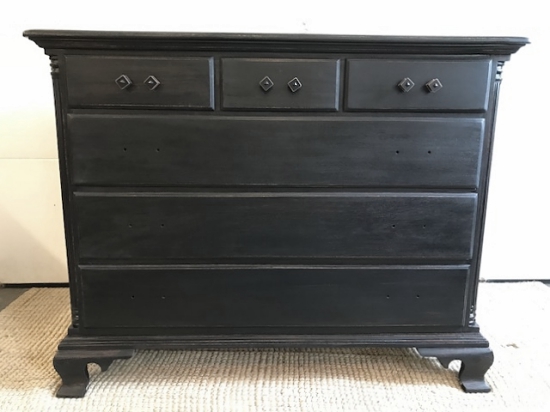
The rule of thumb is to apply the polyurethane, let it completely dry, and then apply the wax. Wax should always be the final topcoat applied to a piece of furniture.
How do I know this?
I once painted a cabinet that crackled after each layer of paint. I sealed it with poly, re-painted, and the paint continued to crackle. Apparently the cabinet had years of buildup of furniture polish (aka wax) and was not allowing the paint and poly to properly adhere.
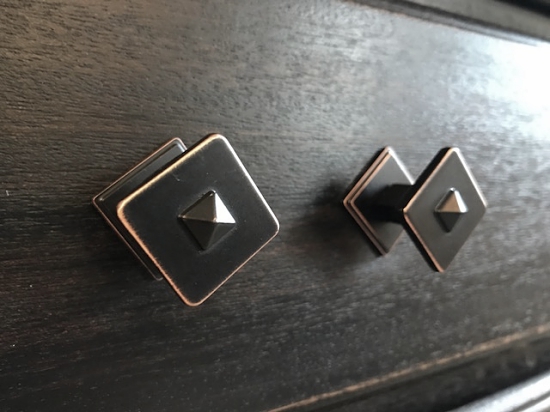
If you prefer to poly a piece of furniture that already has a waxed finish, you must first remove the wax by wiping it down with mineral spirits or a TSP solution. Be sure the area is very well ventilated, wear protective gloves, and I always wear a P-100 rated respirator mask.
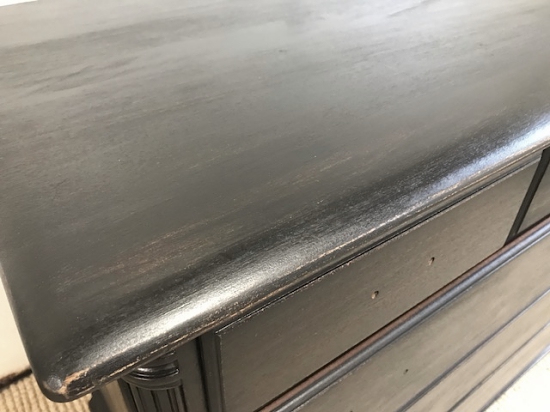
A Warning Before You Choose Furniture Wax
While I absolutely love the way this dresser turned about and the buttery-smooth finish, I have a warning about using wax.
First, wax seems to attract dirt.
On this dark dresser you wouldn’t notice the dirt, but I once waxed a dresser that had a light color tan paint. About 4 years later the client wanted it painted white, so they brought it back to me. I could not believe how many smudges and dirt marks were on this dresser!
The people who had the dresser seemed very clean. But they had little kids and we all know it’s more difficult to keep furniture clean with little hands around.
I’ve never had this problem using polyurethane or polycrylic on a light-colored painted dresser, so I have to only assume it was the wax that was making it difficult to keep the dresser clean.
Second, like I said earlier, you cannot paint over wax and it’s a tedious process to remove the wax later.
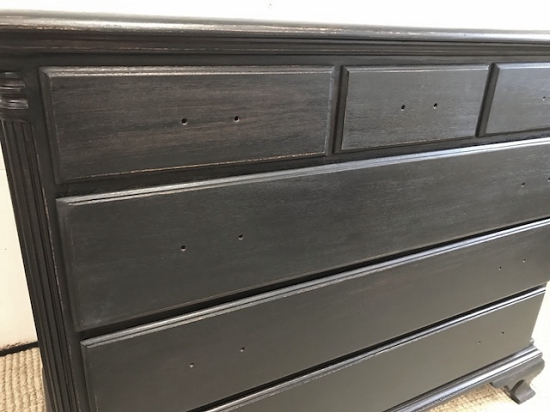
In this stained dresser example I showed you how we applied a wax over a polyurethane topcoat. You can also use this method over paint.
PIN THIS:
Have you used wax over poly? Please share your story in the comments.
And if you like these tutorials, remember to subscribe via email below.



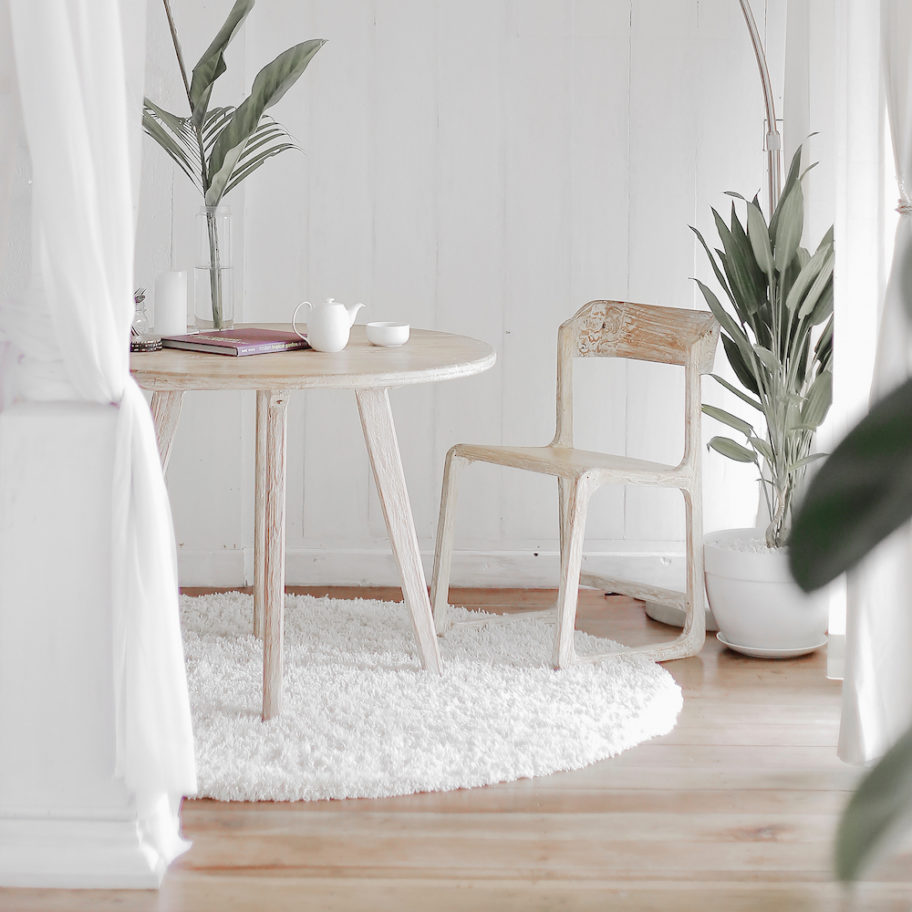

Would the same rule apply to water-based varnish?
Mary, I’ve never tried wax over a water-based varnish, but I don’t think I’d recommend it. I’ve read that the oil-based wax can harm the water-based coating.
Would you use a gloss or matte poly? And how long would you wait after the final poly coat to apply the wax?
I use a satin poly (although a matte poly would provide the needed protection too). Sometimes I use the brush-on poly and sometimes the wipe-on poly. Wait at least 24 hours to dry (and at least 72 hours if you’re in a humid environment) before applying any wax. I don’t recommend adding wax in a humid or hot environment. Even placing a dresser that has a wax next to a warm heater or in direct sunlight has the potential for the wax to melt. Good luck with your project!
I chalk painted and waxed my dining room table. I used too much black wax and now it transfers to anything that sits on the table. I was hoping to be able to use a water based poly to seal it. I love the color but don’t love the wax transferring. Help??
You may want to remove the wax with mineral spirits and if you feel all of the wax was removed, add just a very thin layer back on. I would not recommend using a water-based product over an oil-based wax. The water-base will not adhere to the oil.
I just completed sanding, staining, and sealing an almost twelve foot antique table for my son and his family for Christmas. It is actually a small table with six leaves!! Picked it up for a song. The lesson I received refinishing it was priceless!
I began the project in my garage and then the weather began to turn. (As it does in Nov. in Vermont.) I was at the poly stage of the process and so ready to be finished. This table looked gorgeous! I put one coat on and waited 24 hrs. It looked like I hadn’t done anything. I sanded a little and put the second coat on. The next day when I went out I saw white patches. The temperature had dropped during the night. I had two heaters in the garage that were off for the night. I put them back on to get the temp back up. Then I forgot to sand and applied the third coat. Yes, you know what happened next. Big white patches and the color of the table was horrible. It wasn’t the beautiful Provincial I had applied, It was mousy brown with ugly white skating rinks. My heart sank. Was it the cold? It had to be.
My husband and I moved it into our “furnace room”; the only unfinished part of our basement. I waited a day and nothing changed. I finally called a woodworker I know and asked him. No, it wasn’t the cold. Don’t you know oil and water don’t mix? Years ago when I refinished furniture when my kiddos were little I don’t even think they had water based poly. I used an OIL based stain and a WATER based poly. Never, never, never. Oil with oil and water with water. My only option? You guessed it. Sand down to the bare wood…again and start over. Did you know in the dictionary next the the word perseverance there is a photo of me? So, I got out my sander and my 80 grit and began again. The good news is the table is finished. The reason I went on this website was to see if I can put wax over the poly just to make it a little better. After all this, my son and his wife deserve the best!
Thank you for posting your experience. You just saved me from making that same mistake. I appreciate it!
You’re so welcome Marie. Good luck with your furniture refinishing project.
I’m on a project right now: a table top. I used minwax stain and used Behr water based satin polyurethane. I’m so proud of myself because my table looks wonderful with the poly on it. I had used Behr oil based polyurethane on it before and it was complete fiasco! It never dried and I had to sand it again and restart the project all over. I then decided to use what I had because I didn’t want to buy another product I may not even use later, so I used the water based polyurethane that I had. I sanded the first and second coat. I’m debating on how many coats I should apply for maximum protection. My table top is smooth and gorgeous. I hope it holds up over time. I did let the stain dry 24hr before applying the polyurethane, then waited 12hrs between each coat. After the first coat of polyurethane, I used a space heater in the garage to help it dry more evenly. I hope it helps for your next project.
Jackie, Thank you so much for sharing your experience. Yes, I agree topcoats can be difficult to work with. I actually prefer water-based poly rather than oil-based. I usually apply at least 3 coats to high-use tabletops. The clear will cure/harden over time so be careful with it for the first months or so. Feel free to attach at photo and share your work. We love to see successes!
P.S.- I realize how many typos I have in that post and need to go back and correct those. Guess I was working too quickly that day.
Dear Mary We have sanded down an old english oak table; 3 coats Woodoc oil based polyurethane- sanded after each once dry- now at last one but I do not like the gloss and that is why I googled wax after polyurethane.
It is a humid and hot region on the South Coast in South Africa.
Should i rather leave the wax finish?
If you are in such a warm, humid climate, I suggest testing the poly / wax combination on a random piece of wood first. Let it sit in the sun or where ever you plan to place the furniture and see if the wax melts or gets sticky at all. If it does, you may not want to use the wax.
I’m with Vicki on this. Test it where it doesn’t matter. ( BTW, I opted to leave my wax off. That beautiful table is holding up to a three year old and lots of large family gatherings. ) 😊